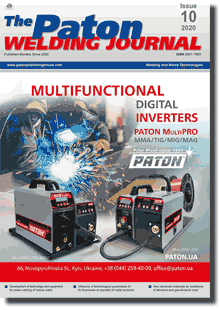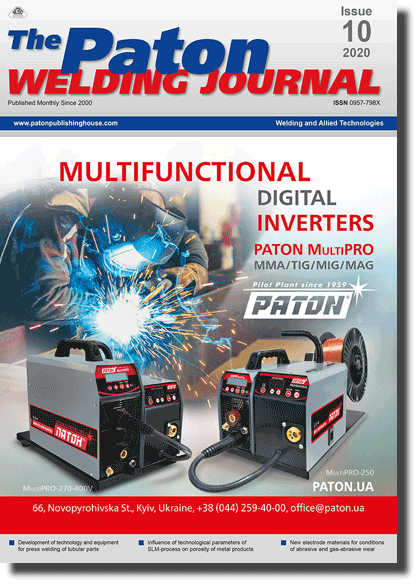| 2020 №10 (05) |
DOI of Article 10.37434/tpwj2020.10.06 |
2020 №10 (07) |

The Paton Welding Journal, 2020, #10, 31-34 pages
Development of new electrode materials, methods of restoration and protection of thin-walled parts of equipment, which are operated under the conditions of abrasive and gas-abrasive wear
M.M. Student, A.A. Voytovych, Ya.Ya. Sirak and V.M. Gvozdetskyi
G.V. Karpenko Physical-Mechanical Institute of the NAS of Ukraine 5 Naukova Str., 79060, Lviv, Ukraine. E-mail: pminasu@ipm.lviv.ua
Abstract
A wide range of parts and equipment of chemical, oil, agricultural, machine-building, transport, energy and other industries are operated under abrasive wear conditions. In Ukraine, electric arc surfacing with flux-cored wires of the Fe–Cr–B–C system is widely used to protect against abrasive wear and restore worn surfaces by surfacing. Such fluxcored wires have a low cost and the deposited metal has a satisfactory wear resistance. However, the main disadvantage of the layers deposited by such flux-cored wires, are dendrites of the first and second order with acicular morphology. Sharp peaks of the solid phase act as stress concentrators, from which after impact the cracking of the deposited metal begins, followed by its chipping. It is known that the formation of rounded reinforcing phases reduces the concentration of stresses in the deposited layer and, as a consequence, increases wear resistance. This paper proposes the dispersion of structural components in the deposited metal by surfacing under the action of mechanical vibration on the deposited metal, which is especially rational to use for manufacture by surfacing of bimetallic wear plates, and for large-sized parts it is proposed to perform a dispersion of structural components in the deposited metal with modifying charge flux-cored wires of Fe–Cr–B–C system by adding PAM-4 powder of aluminium-magnesium master alloy to it. 5 Ref., 2 Tables, 5 Figures.
Keywords: surfacing, bimetallic sheets, wear resistance, boride inclusions
Received 28.09.2020
References
1. Kuskov, Y.М., Zhdanov, V.А., Ryabtsev, І.О. et al. (2020) Methods for Increasing the Corrosion Resistance of Coatings Deposited under a Flux Layer from High-Chromium Powder Wires. Materials Science, 55, 5, 710-715. https://doi.org/10.1007/s11003-020-00362-92. Student, M., Vojtovych, A., Pokhmurska, H. et al. (2019) Mechanical characteristics and wear resistance of the cladding layers obtained by melting of cored wires with simultaneous vibration of substrate. Strojnicky Casopis, 69, 1, 109-122. https://doi.org/10.2478/scjme-2019-0009
3. Pokhmurs`ka, H.V., Student, M.M., Lanets`, O.S., Voitovych, A.A. (2015) Influence of Vibration in the Course of Surfacing of a Protective Layer on Its Microstructure and Impact- Abrasive Wear. Materials Science, 51, 3, 412-417. https://doi.org/10.1007/s11003-015-9856-2
4. Voitovych, A.A., Pokhmurs`ka, H.V., Student, M.M., Student, O.Z. (2016) Microstructure and abrasive-wear resistance of the vibration-deposited metal of core wires of the basic Fe-Cr-B system. Ibid, 52, 3, 365-370. https://doi.org/10.1007/s11003-016-9965-6
5. Pokhmurs`ka, H.V., Student, M.M., Dzyubyk, A.R. et al. (2017) Corrosion resistance of the metal vibration deposited from fluxcore wires based on the Fe-Cr-B system. Ibid, 52, 5, 694-699. https://doi.org/10.1007/s11003-017-0011-0
Suggested Citation
M.M. Student, A.A. Voytovych, Ya.Ya. Sirak and V.M. Gvozdetskyi (2020) Development of new electrode materials, methods of restoration and protection of thin-walled parts of equipment, which are operated under the conditions of abrasive and gas-abrasive wear. The Paton Welding J., 10, 31-34.The cost of subscription/purchase order journals or individual articles
| Journal/Currency | Annual Set | 1 issue printed |
1 issue |
one article |
| TPWJ/USD | 384 $ | 32 $ | 26 $ | 13 $ |
| TPWJ/EUR | 348 € | 29 € | 24 € | 12 € |
| TPWJ/UAH | 7200 UAH | 600 UAH | 600 UAH | 280 UAH |
| AS/UAH | 1800 UAH | 300 UAH | 300 UAH | 150 UAH |
| AS/USD | 192 $ | 32 $ | 26 $ | 13 $ |
| AS/EUR | 180 € | 30 € | 25 € | 12 € |
| SEM/UAH | 1200 UAH | 300 UAH | 300 UAH | 150 UAH |
| SEM/USD | 128 $ | 32 $ | 26 $ | 13 $ |
| SEM/EUR | 120 € | 30 € | 25 € | 12 € |
| TDNK/UAH | 1200 UAH | 300 UAH | 300 UAH | 150 UAH |
| TDNK/USD | 128 $ | 32 $ | 26 $ | 13 $ |
| TDNK/EUR | 120 € | 30 € | 25 € | 15 € |
AS = «Automatic Welding» - 6 issues per year;
TPWJ = «PATON WELDING JOURNAL» - 12 issues per year;
SEM = «Electrometallurgy Today» - 4 issues per year;
TDNK = «Technical Diagnostics and Non-Destructive Testing» - 4 issues per year.


